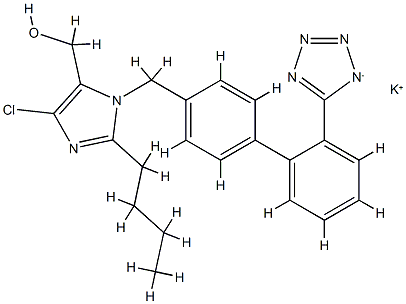Erythropoietin: Neuroprotective Function, Therapeutic Effect in Glaucoma and Side Effects
Apr 12,2024
General Description
Erythropoietin exhibits neuroprotective functions through various signaling pathways, contributing to cognition improvement, neurogenesis, and tissue protection beyond its hematopoietic effects. In the context of glaucoma, Erythropoietin has shown promising therapeutic effects by promoting RGC survival, regeneration, and protection through pathways like PI3K/Akt and JAK2/STAT3. However, Erythropoietin therapy is associated with potential side effects such as increased blood viscosity, polycythemia, neurological issues, and a possible link to tumor growth. Close monitoring, dosage adjustments, and careful consideration of risks are essential for the safe and effective use of Erythropoietin in patients, especially those with specific medical conditions.

Figure 1. Erythropoietin
Neuroprotective Function
Erythropoietin is known for its role in stimulating erythropoiesis, but it also exhibits neuroprotective functions beyond its hematopoietic effects. Erythropoietin binds to its receptor, EPOR, leading to the activation of various signaling pathways such as JAK2/STAT5, MAPK, ERK, PI-3-K/Akt, and NF-kB. This activation promotes the survival and maturation of erythroid progenitors and proerythroblasts. In addition to its hematopoietic functions, Erythropoietin and its receptor have been found in various extra-hematopoietic tissues, including the nervous system. Studies have shown that Erythropoietin has pluripotent potential in the nervous system, contributing to cognition improvement, neurogenesis, and exhibiting anti-fibrotic, anti-apoptotic, anti-oxidative, and anti-inflammatory effects. The presence of different isoforms of EPOR, such as the EPOR/βcR heterodimer, suggests tissue-protective effects of EPO beyond erythropoiesis. Experimental evidence, including studies on cardiomyocytes and spinal cord injury models, supports the idea that the EPOR/βcR heterodimer plays a role in tissue protection. In retinal tissues, the expression of the EPOR/βcR heterodimer complex further highlights its potential neuroprotective functions. Overall, Erythropoietin's neuroprotective functions are mediated through its interaction with EPOR and the activation of specific signaling pathways, contributing to various beneficial effects in the nervous system beyond its traditional role in erythropoiesis. 1
Therapeutic Effect in Glaucoma
Erythropoietin has shown promising therapeutic effects in glaucoma, a condition characterized by the progressive death of retinal ganglion cells (RGCs) and irreversible visual field loss. Research has explored both local and systemic administration of Erythropoietin to target optic neuropathies like glaucoma. Studies have demonstrated that Erythropoietin can cross the blood-brain barrier and blood-retinal barrier to exert its neuroprotective actions in the central nervous system and eyes. In experimental models of mechanical optic nerve injury, Erythropoietin has been found to have anti-apoptotic effects on RGCs. The neuroprotective function of Erythropoietin follows a dose-response curve without toxicity, making it a promising therapeutic agent against neuronal apoptosis in glaucoma. Different signaling pathways, such as the PI3K/Akt pathway and the ERK-1/-2 pathway, have been implicated in mediating Erythropoietin's neuroprotective effects on RGCs. Additionally, EPO has been shown to promote axonal survival, regeneration, and protection of injured RGCs in glaucoma models, potentially through pathways like JAK2/STAT3 and upregulation of growth-associated proteins. Furthermore, sustained release EPO-loaded microspheres have been investigated for their efficacy in preventing RGC death in optic nerve crush models, demonstrating effectiveness comparable to multiple Erythropoietin injections. These findings highlight the therapeutic potential of Erythropoietin in treating glaucoma and other neurodegenerative diseases affecting the central nervous system. 2
Side Effects
Erythropoietin, while showing therapeutic promise in various conditions, is associated with potential side effects that need to be carefully considered. One common side effect of Erythropoietin therapy is the risk of increasing blood viscosity, which can lead to adverse cardiovascular events such as hypertension, thrombosis, and stroke. Additionally, excessive Erythropoietin administration may stimulate the production of red blood cells beyond normal levels, resulting in polycythemia. This condition can lead to complications like increased blood clotting tendencies and reduced blood flow to tissues. Furthermore, EPO treatment may also have neurological side effects, including seizures, especially when administered at high doses. Some studies have suggested a potential link between Erythropoietin use and tumor growth, although further research is needed to clarify this association. Patients with certain conditions like uncontrolled hypertension or a history of blood clots may be at higher risk of experiencing these side effects when undergoing Erythropoietin therapy. It is crucial for healthcare providers to monitor patients receiving Erythropoietin treatment closely, adjust dosages appropriately, and weigh the benefits against the potential risks to ensure the safe and effective use of this medication. 3
Reference
1. Bhoopalan SV, Huang LJ, Weiss MJ. Erythropoietin regulation of red blood cell production: from bench to bedside and back. F1000Res. 2020; 9: F1000 Faculty Rev-1153.
2. Lin TY, Lai YF, Chen YH, Lu DW. The Latest Evidence of Erythropoietin in the Treatment of Glaucoma. Int J Mol Sci. 2022; 23(24): 16038.
3. Lagrèze WA, Küchlin S, Ihorst G, et al. Safety and efficacy of erythropoietin for the treatment of patients with optic neuritis (TONE): a randomised, double-blind, multicentre, placebo-controlled study. Lancet Neurol. 2021; 20(12): 991-1000.
- Related articles
- Related Qustion
- A glycoprotein cytokine: Erythropoietin Oct 25, 2023
Erythropoietin (EPO) is the main regulator of red blood cell production. It is secreted mainly by the kidneys in response to cellular hypoxia.
2-Naphthylacetonitrile is a key compound in pharmaceutical synthesis, serving as a c-Myc protein inhibitor and can be prepared by palladium-catalyzed decarboxylative coupling method.....
Apr 12,2024APIZirconium hydride's diverse properties enhance high-temperature applications, hydrogen storage, and mechanical strength in composites, promising innovation across industries.....
Apr 12,2024APIErythropoietin
11096-26-7You may like
- EPO
-

- $20.00 / 1Box
- 2024-05-31
- CAS:11096-26-7
- Min. Order: 1Box
- Purity: 99%
- Supply Ability: 1000 boxs
- EPO
-

- $50.00/ Box
- 2024-05-29
- CAS:11096-26-7
- Min. Order: 1Box
- Purity: 99.9%
- Supply Ability: 20000box
- Erythropoietin
-

- $10.00 / 1kg
- 2024-03-08
- CAS:11096-26-7
- Min. Order: 1kg
- Purity: 99%
- Supply Ability: 1000kg




